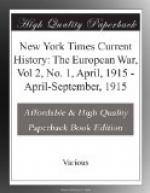These were the complex problems we had to discuss and adjust, and we had to determine how we could most effectually mobilize the financial resources of the Allies so as to be of the greatest help to the common cause. For the moment undoubtedly ours is still the best market in the world. An alliance in a great war to be effective needs that each country must bring all its resources, whatever they are, into the common stock. An alliance for war cannot be conducted on limited liability principles. If one country in the alliance has more trained and armed men ready with guns, rifles, and ammunition than another she must bring them all up against the common enemy, without regard to the fact that the others cannot for the moment make a similar contribution. But it is equally true that the same principle applies to the country with the larger navy or the country with the greater resources in capital and credit. They must be made available to the utmost for the purpose of the alliance, whether the other countries make a similar contribution or not. That is the principle upon which the conference determined to recommend to their respective Governments a mobilization of our financial resources for the war.
The first practical suggestion we had to consider was the suggestion that has been debated very considerably in the press—the suggestion of a joint loan. We discussed that very fully and we came to the conclusion that it was the very worst way of utilizing our resources. It would have frightened every Bourse and attracted none. It would have made the worst of every national credit and the best of none. Would the interest paid have been the interest upon which we could raise money, the rate at which France could have raised money, or the rate at which Russia could raise money? If we paid a high rate of interest we could never raise more money at low rates. If instead of raising L350,000,000 a few weeks ago for our own purposes we had floated a great joint loan of L1,000,000,000, the House can very well imagine what the result would have been. We decided after a good deal of discussion and reflection that each country should raise money for its own needs within its own markets in so far as their conditions allowed, but that if help were needed by any country for outside purchases then those who could best afford to render assistance for the time being should do so.
There was only one exception which we decided to recommend, and that was in the case of borrowings by small States. We decided that each of the great allied countries should contribute a portion of every loan made to the small States who were either in with us now or prepared to come in later on, that the responsibility should be divided between the three countries, and that at an opportune moment a joint loan should be floated to cover the advances either already made, or to be made, to these countries outside the three great allied countries. That was the only exception




